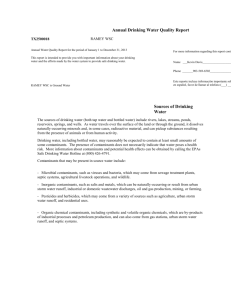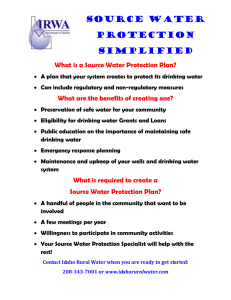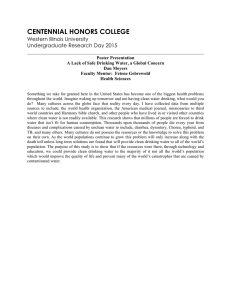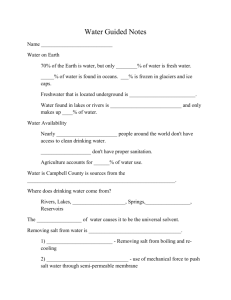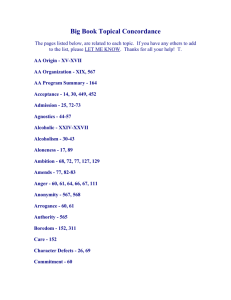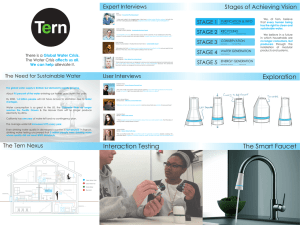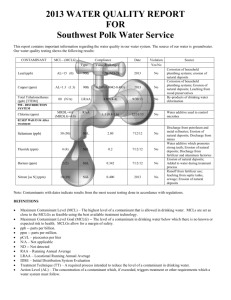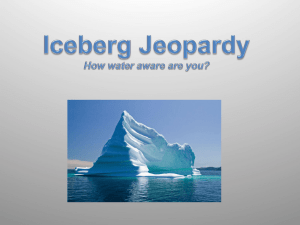Prairie View A and M University 2012 Drinking Water Quality Report
advertisement
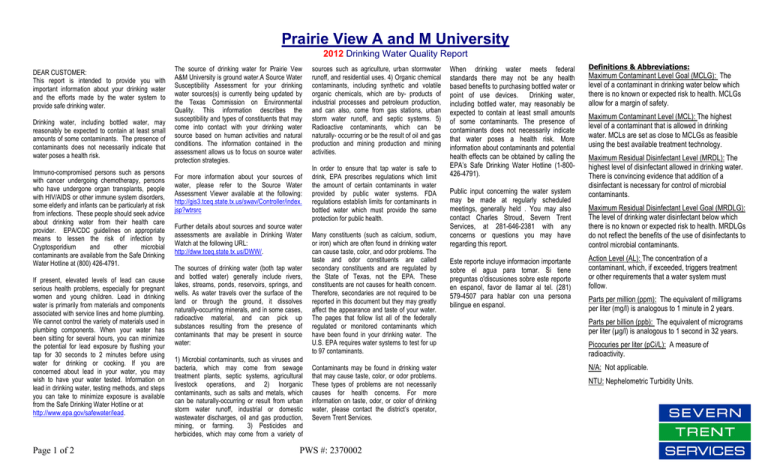
Prairie View A and M University 2012 Drinking Water Quality Report DEAR CUSTOMER: This report is intended to provide you with important information about your drinking water and the efforts made by the water system to provide safe drinking water. Drinking water, including bottled water, may reasonably be expected to contain at least small amounts of some contaminants. The presence of contaminants does not necessarily indicate that water poses a health risk. Immuno-compromised persons such as persons with cancer undergoing chemotherapy, persons who have undergone organ transplants, people with HIV/AIDS or other immune system disorders, some elderly and infants can be particularly at risk from infections. These people should seek advice about drinking water from their health care provider. EPA/CDC guidelines on appropriate means to lessen the risk of infection by Cryptosporidium and other microbial contaminants are available from the Safe Drinking Water Hotline at (800) 426-4791. If present, elevated levels of lead can cause serious health problems, especially for pregnant women and young children. Lead in drinking water is primarily from materials and components associated with service lines and home plumbing. We cannot control the variety of materials used in plumbing components. When your water has been sitting for several hours, you can minimize the potential for lead exposure by flushing your tap for 30 seconds to 2 minutes before using water for drinking or cooking. If you are concerned about lead in your water, you may wish to have your water tested. Information on lead in drinking water, testing methods, and steps you can take to minimize exposure is available from the Safe Drinking Water Hotline or at http://www.epa.gov/safewater/lead. Page 1 of 2 The source of drinking water for Prairie Vew A&M University is ground water.A Source Water Susceptibility Assessment for your drinking water sources(s) is currently being updated by the Texas Commission on Environmental Quality. This information describes the susceptibility and types of constituents that may come into contact with your drinking water source based on human activities and natural conditions. The information contained in the assessment allows us to focus on source water protection strategies. For more information about your sources of water, please refer to the Source Water Assessment Viewer available at the following: http://gis3.tceq.state.tx.us/swav/Controller/index. jsp?wtrsrc Further details about sources and source water assessments are available in Drinking Water Watch at the following URL: http://dww.tceq.state.tx.us/DWW/. The sources of drinking water (both tap water and bottled water) generally include rivers, lakes, streams, ponds, reservoirs, springs, and wells. As water travels over the surface of the land or through the ground, it dissolves naturally-occurring minerals, and in some cases, radioactive material, and can pick up substances resulting from the presence of contaminants that may be present in source water: 1) Microbial contaminants, such as viruses and bacteria, which may come from sewage treatment plants, septic systems, agricultural livestock operations, and 2) Inorganic contaminants, such as salts and metals, which can be naturally-occurring or result from urban storm water runoff, industrial or domestic wastewater discharges, oil and gas production, mining, or farming. 3) Pesticides and herbicides, which may come from a variety of sources such as agriculture, urban stormwater runoff, and residential uses. 4) Organic chemical contaminants, including synthetic and volatile organic chemicals, which are by- products of industrial processes and petroleum production, and can also, come from gas stations, urban storm water runoff, and septic systems. 5) Radioactive contaminants, which can be naturally- occurring or be the result of oil and gas production and mining production and mining activities. In order to ensure that tap water is safe to drink, EPA prescribes regulations which limit the amount of certain contaminants in water provided by public water systems. FDA regulations establish limits for contaminants in bottled water which must provide the same protection for public health. Many constituents (such as calcium, sodium, or iron) which are often found in drinking water can cause taste, color, and odor problems. The taste and odor constituents are called secondary constituents and are regulated by the State of Texas, not the EPA. These constituents are not causes for health concern. Therefore, secondaries are not required to be reported in this document but they may greatly affect the appearance and taste of your water. The pages that follow list all of the federally regulated or monitored contaminants which have been found in your drinking water. The U.S. EPA requires water systems to test for up to 97 contaminants. Contaminants may be found in drinking water that may cause taste, color, or odor problems. These types of problems are not necessarily causes for health concerns. For more information on taste, odor, or color of drinking water, please contact the district’s operator, Severn Trent Services. PWS #: 2370002 When drinking water meets federal standards there may not be any health based benefits to purchasing bottled water or point of use devices. Drinking water, including bottled water, may reasonably be expected to contain at least small amounts of some contaminants. The presence of contaminants does not necessarily indicate that water poses a health risk. More information about contaminants and potential health effects can be obtained by calling the EPA’s Safe Drinking Water Hotline (1-800426-4791). Public input concerning the water system may be made at regularly scheduled meetings, generally held . You may also contact Charles Stroud, Severn Trent Services, at 281-646-2381 with any concerns or questions you may have regarding this report. Este reporte incluye informacion importante sobre el agua para tomar. Si tiene preguntas o'discusiones sobre este reporte en espanol, favor de llamar al tel. (281) 579-4507 para hablar con una persona bilingue en espanol. Definitions & Abbreviations: Maximum Contaminant Level Goal (MCLG): The level of a contaminant in drinking water below which there is no known or expected risk to health. MCLGs allow for a margin of safety. Maximum Contaminant Level (MCL): The highest level of a contaminant that is allowed in drinking water. MCLs are set as close to MCLGs as feasible using the best available treatment technology. Maximum Residual Disinfectant Level (MRDL): The highest level of disinfectant allowed in drinking water. There is convincing evidence that addition of a disinfectant is necessary for control of microbial contaminants. Maximum Residual Disinfectant Level Goal (MRDLG): The level of drinking water disinfectant below which there is no known or expected risk to health. MRDLGs do not reflect the benefits of the use of disinfectants to control microbial contaminants. Action Level (AL): The concentration of a contaminant, which, if exceeded, triggers treatment or other requirements that a water system must follow. Parts per million (ppm): The equivalent of milligrams per liter (mg/l) is analogous to 1 minute in 2 years. Parts per billion (ppb): The equivalent of micrograms per liter (µg/l) is analogous to 1 second in 32 years. Picocuries per liter (pCi/L): A measure of radioactivity. N/A: Not applicable. NTU: Nephelometric Turbidity Units. Substance Unit of Measure Year MCL Average Level Detected Minimum Maximum Level Detected MCLG In Compliance Typical Sources Radioactive Contaminants (Regulated at the Water Plant) Combined Radium pCi/L 2010 5 1.28 0.86 - 1.7 0 Yes Erosion of natural deposits. Gross Alpha pCi/L 2010 15 5.65 4 - 7.3 0 Yes Erosion of natural deposits. Gross Beta pCi/L 2010 50 6.9 6.6 - 7.2 0 Yes Decay of natural and man-made deposits. Inorganic Contaminants (Regulated at the Water Plant) Nitrate ppm 2012 10 0.01 0 - 0.01 10 Yes Runoff from fertilizer use; leaching from septic tanks, sewage; erosion from natural deposits. Fluoride ppm 2011 4 0.42 0.39 - 0.44 4 Yes Erosion of natural deposits; water additive which promotes strong teeth; discharge from fertilizer and aluminum factories. Arsenic ppb 2011 10 3.3 3.3 - 3.3 0 Yes Erosion of natural deposits; runoff from orchards; runoff from glass, and electronics production wastes. Barium ppm 2011 2 0.184 0.184 - 0.184 2 Yes Discharge of drilling wastes; discharge from metal refineries; erosion of natural deposits. ppb 2010 80 3.8 0 - 7.6 0 Yes By-product of drinking water disinfection. Disinfectant Byproducts Total Trihalomethanes Substance Unit of Measure Year MRDL Average Level Detected Minimum Maximum Level Detected MRDLG In Compliance 2012 4.0 1.45 1.2 - 1.73 4.0 Yes Number of Results above Action Level MCLG In Compliance Typical Sources Maximum Residual Disinfectant Level Chlorine Residual ppm Unit of Substance Measure Lead and Copper (Regulated at Customers Tap) Year 90th Percentile Value EPA Action Level Water additive used to control microbes. Typical Sources Lead ppb 2010 3.27 15 0 0 Yes Corrosion of household plumbing systems; erosion of natural deposits. Copper ppm 2010 0.76 1.3 0 1.3 Yes Corrosion of household plumbing systems, erosion of natural deposits; leaching from wood preservatives. * All levels detected were below the MCLs. Page 2 of 2 PWS #: 2370002
